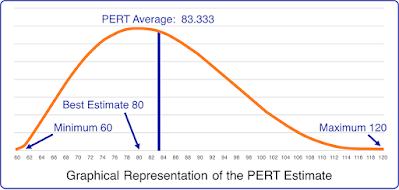Task Effort as a Random Value
The effort need to complete a project task as well as the whole project effort can be treated as a random value. One of the goals of project estimate is to find a confidence interval for the project effort with high confidence level.
From empirical evidence we know that task probability distribution loos like this:
The long right tail is a sort of an implication of Parkinson's ("work expands so as to fill the time available for its completion.") and Murphy's laws ( "whatever can go wrong, will go wrong.").
Finding Expected Value
The first step is to find the expected value of the task estimate (strictly speaking we will estimate the expected value as the true distribution is unknown to us).
Three point estimation is probably the most famous technique to do that. However I will allow myself to criticize it a little. It is not always easy to get an adequate (minimal, maximum and realistic) estimate for a task. It also seems more intuitive and fast to make a realistic estimate and assess a risk, i.e. the confidence of the estimator in his estimate.
Shifting the realistic estimate to the right by adding a risk or using Three Point technique will give a good enough estimate of the task's expected value.
Adding things up
It is not obvious and needs proof that project estimate is equal to the sum of estimates of its tasks. One of the greatest math theorems, the
Central Limit Theorem can help us here. It states that with some assumptions (independent random values, large enough number of them) the distribution of sum of such values will be close to normal.
Source
Increasing the confidence interval
It means that if we take the sum of out tasks' estimate as project estimate, we will only hit 50% probability to fit into our estimate. Pure math. This is why adding a project buffer is crucial for project success. Three point estimate even provides a numerical way to find such an interval with required confidence level. In simpler case you can add up 5% to 15% depending on your intuition and perception of overall project risk.
NB: The math above only works if the actual scope of your project (i.e. the list and contents of tasks)is the same as you estimated. Project buffer does not save you from new scope. It is managed by assumptions or even larger increase of the buffer.


Comments
Post a Comment